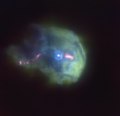File:A stellar sprinkler (potw2316a).tiff
Page contents not supported in other languages.
Tools
Actions
General
In other projects
Appearance

Size of this JPG preview of this TIF file: 619 × 599 pixels. Other resolutions: 248 × 240 pixels | 496 × 480 pixels | 684 × 662 pixels.
Original file (684 × 662 pixels, file size: 2.63 MB, MIME type: image/tiff)
| This is a file from the Wikimedia Commons. Information from its description page there is shown below. Commons is a freely licensed media file repository. You can help. |
Summary
| DescriptionA stellar sprinkler (potw2316a).tiff |
English: This Picture of the Week shows the young stellar object 244-440 in the Orion Nebula observed with ESO’s Very Large Telescope (VLT) –– the sharpest image ever taken of this object. That wiggly magenta structure is a jet of matter launched close to the star, but why does it have that shape?Very young stars are often surrounded by discs of material falling towards the star. Some of this material can be expelled into powerful jets perpendicularly to the disc. The S-shaped jet of 244-440 suggests that what lurks at the center of this object isn’t one but two stars orbiting each other. This orbital motion periodically changes the orientation of the jet, similar to a water sprinkler. Another possibility is that the strong radiation from the other stars in the Orion cloud could be altering the shape of the jet.These observations, presented in a new paper led by Andrew Kirwan at Maynooth University in Ireland, were taken with the Multi Unit Spectroscopic Explorer (MUSE) instrument at ESO’s VLT in Chile. Red, green and blue colours show the distribution of iron, nitrogen and oxygen respectively. But this is just a small fraction of all the data gathered by MUSE, which actually takes thousands of images at different colours or wavelengths simultaneously. This allows astronomers to study not only the distribution of many different chemical elements but also how they move. Moreover, MUSE is installed at the VLT’s Unit Telescope 4, which is equipped with an advanced adaptive optics facility that corrects atmospheric turbulence, delivering images sharper than Hubble’s. These new observations will therefore allow astronomers to study with unprecedented detail how stars are born in massive clouds like Orion. |
||
| Date | 17 April 2023 (upload date) | ||
| Source |
|
||
| Author | ESO/Kirwan et al. | ||
| Other versions |
|
Licensing
 |
This media was created by the European Southern Observatory (ESO).
Their website states: "Unless specifically noted, the images, videos, and music distributed on the public ESO website, along with the texts of press releases, announcements, pictures of the week, blog posts and captions, are licensed under a Creative Commons Attribution 4.0 International License, and may on a non-exclusive basis be reproduced without fee provided the credit is clear and visible." To the uploader: You must provide a link (URL) to the original file and the authorship information if available. |
This file is licensed under the Creative Commons Attribution 4.0 International license.
| |
Captions
Add a one-line explanation of what this file represents
Items portrayed in this file
depicts
image/tiff
aed4aa6efbc8149e3adc52d12a56d8a108cd9317
2,752,804 byte
662 pixel
684 pixel
File history
Click on a date/time to view the file as it appeared at that time.
| Date/Time | Thumbnail | Dimensions | User | Comment | |
|---|---|---|---|---|---|
| current | 03:48, 18 April 2023 |  | 684 × 662 (2.63 MB) | OptimusPrimeBot | #Spacemedia - Upload of https://cdn.eso.org/images/original/potw2316a.tif via Commons:Spacemedia |
File usage
The following page uses this file:
Metadata
This file contains additional information, probably added from the digital camera or scanner used to create or digitize it.
If the file has been modified from its original state, some details may not fully reflect the modified file.
| Width | 684 px |
|---|---|
| Height | 662 px |
| Bits per component |
|
| Compression scheme | Uncompressed |
| Pixel composition | RGB |
| Image data location | 25,796 |
| Orientation | Normal |
| Number of components | 3 |
| Number of rows per strip | 662 |
| Bytes per compressed strip | 2,716,848 |
| Horizontal resolution | 10 dpc |
| Vertical resolution | 10 dpc |
| Data arrangement | chunky format |
| Software used | Adobe Photoshop 24.3 (Windows) |
| File change date and time | 13:29, 31 March 2023 |
| Color space | sRGB |

